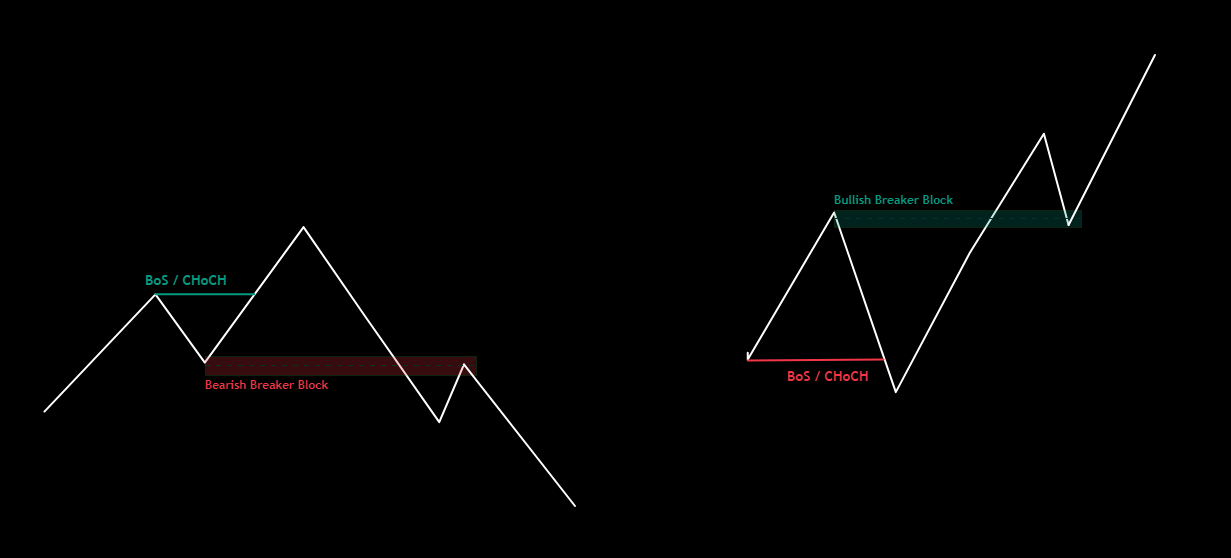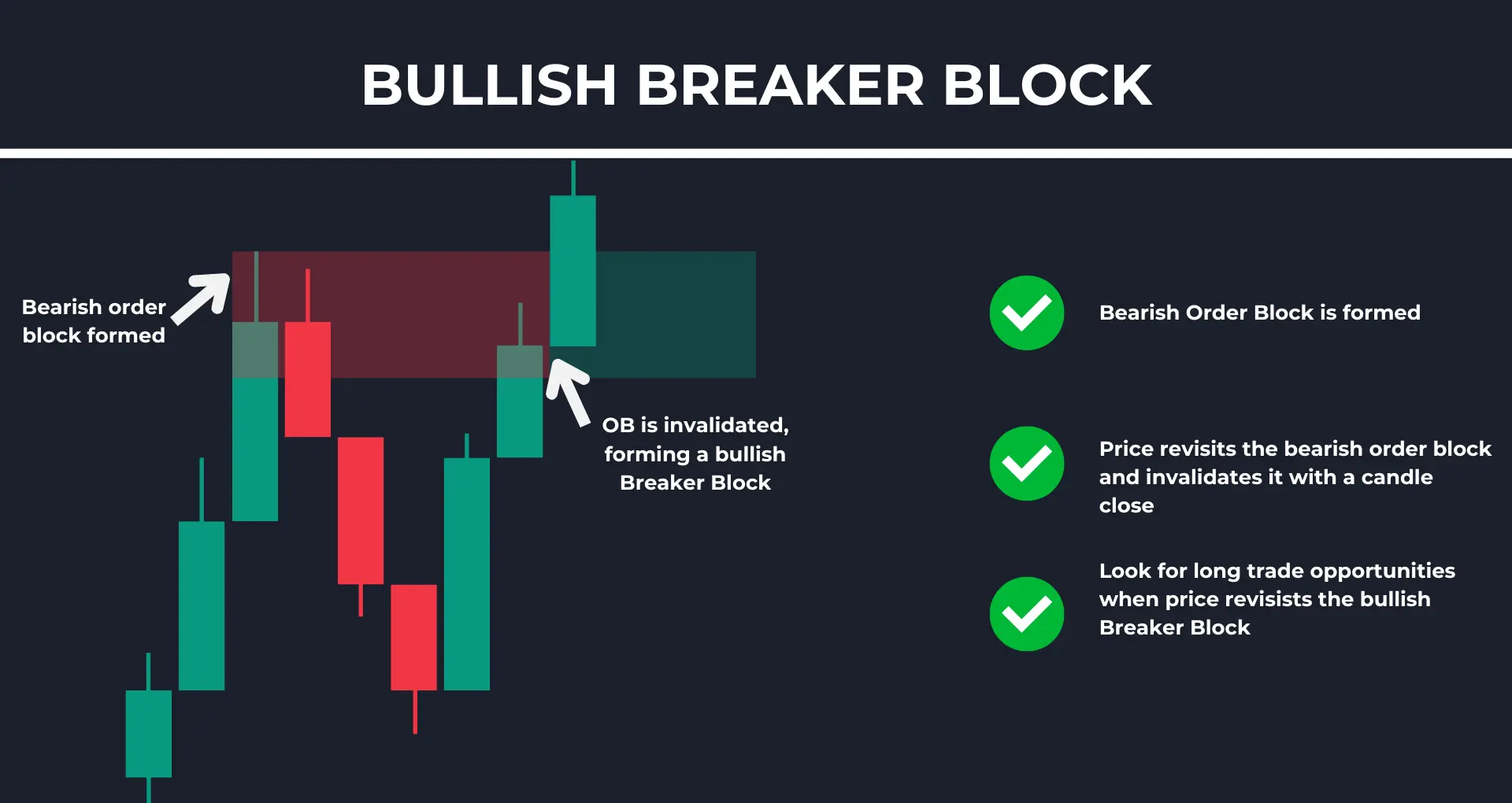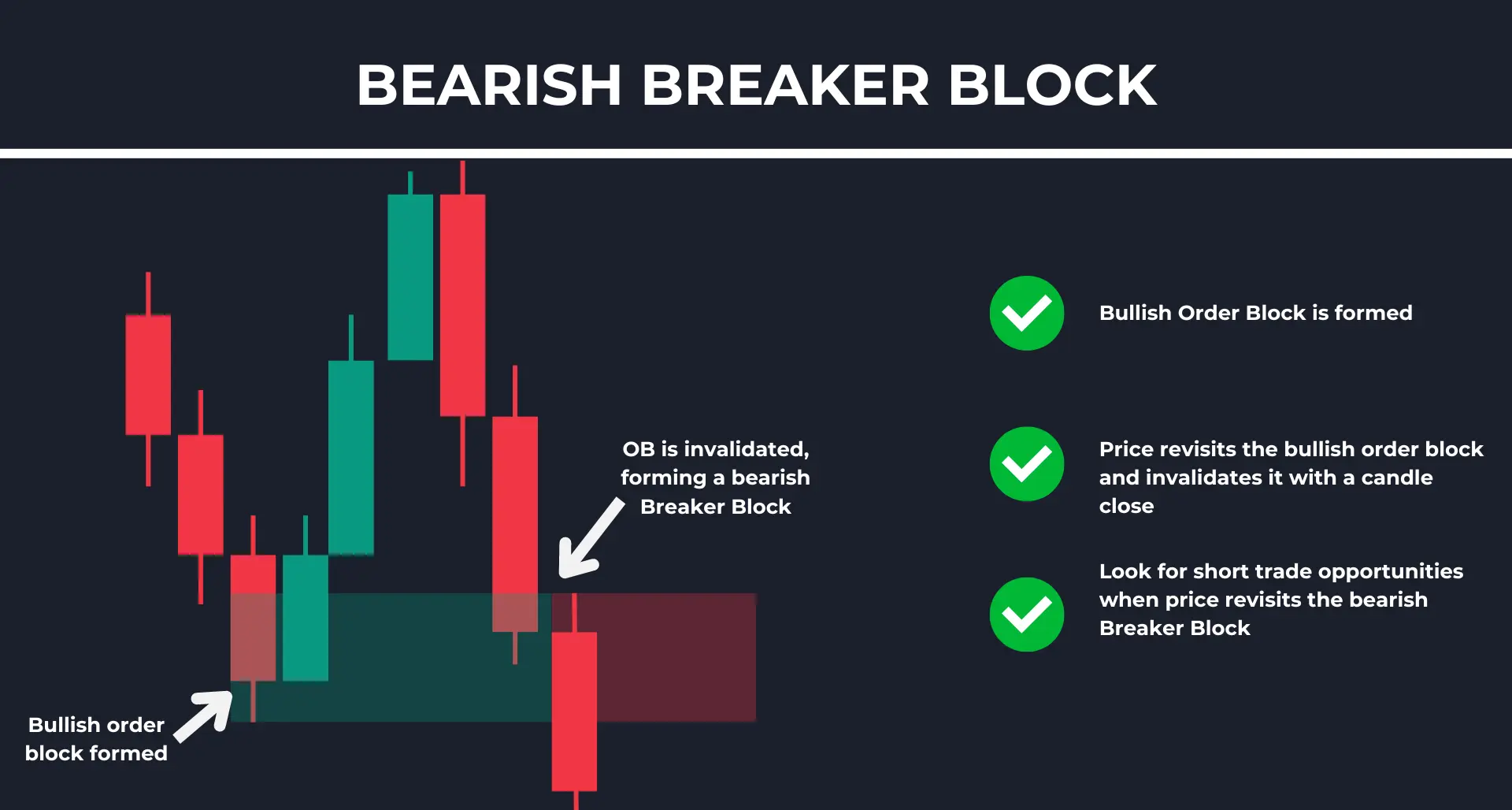Breaker Blocks: Failed Order Blocks & Structure Shifts

What are Breaker Blocks?
Breaker blocks are a powerful price action concept that identifies specific zones where market structure has shifted, creating high-probability reversal or continuation areas. These blocks represent failed order blocks that have led to a significant change in market direction and liquidity flow.
Unlike traditional support and resistance levels, breaker blocks are formed when an order block fails, resulting in a break of market structure. This failure creates a zone that often acts with increased significance when price returns to test it in the future. Institutional traders frequently use these zones to execute large positions, making them invaluable for retail traders to identify.
Breaker blocks are particularly valuable because they represent areas where market participants have been trapped on the wrong side of the market. When price returns to these zones, those trapped traders often exit their positions, creating additional momentum in the new trend direction.
Types of Breaker Blocks
Bullish Breaker Block

A bullish breaker block forms when a bearish order block fails to act as resistance, and price breaks above it, creating a significant shift in market structure. This occurs when:
- A bearish order block initially causes price to reverse lower
- Price then takes liquidity from the downside, breaking below a previous low
- Instead of continuing lower, price reverses and breaks back above the order block
- This failed bearish order block now becomes a bullish breaker block
- When price later returns to test this zone, it often finds support and continues upward
Bullish breaker blocks highlight areas where sellers have been trapped, creating a potential support zone when price retraces. They're often accompanied by institutional buying as smart money sees the opportunity to drive prices higher against trapped short positions.
Bearish Breaker Block

A bearish breaker block forms when a bullish order block fails to act as support, and price breaks below it, creating a significant shift in market structure. This happens when:
- A bullish order block initially causes price to reverse higher
- Price then takes liquidity from the upside, breaking above a previous high
- Instead of continuing higher, price reverses and breaks back below the order block
- This failed bullish order block now becomes a bearish breaker block
- When price later returns to test this zone, it often acts as resistance and continues downward
Bearish breaker blocks represent areas where buyers have been trapped, creating a potential resistance zone when price retraces. They're frequently accompanied by institutional selling as smart money capitalizes on the opportunity to drive prices lower against trapped long positions.
Why Breaker Blocks Are Important
Breaker blocks have become a cornerstone of advanced price action trading for several key reasons:
- Trapped Market Participants - They identify zones where traders are caught on the wrong side of the market, creating powerful momentum when these positions are forced to close
- Institutional Activity - These zones often align with areas where large market participants are executing significant orders
- High-Probability Setups - When properly identified, breaker blocks create some of the highest-probability entry and exit points
- Market Structure Insight - They help traders understand significant shifts in market structure and sentiment
- Clear Risk Management - Breaker blocks provide well-defined zones for stop placement, improving risk-to-reward ratios
How to Identify Breaker Blocks
Identifying breaker blocks requires attention to market structure and specific price action sequences:
For Bullish Breaker Blocks:
- Identify a bearish order block that causes a downward price movement
- Look for price to take liquidity by breaking below a previous low
- Watch for price to then reverse and break back above the order block
- The area of the original bearish order block now becomes a bullish breaker block
- This zone will likely act as support when price retraces back to it
For Bearish Breaker Blocks:
- Identify a bullish order block that causes an upward price movement
- Look for price to take liquidity by breaking above a previous high
- Watch for price to then reverse and break back below the order block
- The area of the original bullish order block now becomes a bearish breaker block
- This zone will likely act as resistance when price retraces back to it
Key Characteristics of Valid Breaker Blocks:
- The original order block must be clearly defined
- There must be a clear liquidity grab (breaking of previous high/low)
- The break back through the order block should be decisive
- Volume often increases during the formation of breaker blocks
- The stronger the market structure break, the more significant the breaker block
How to Trade Using Breaker Blocks
Trading with breaker blocks can be simplified into these key steps:
- Identify the Breaker Block - Use the guidelines above to locate valid breaker blocks on your chart
- Wait for Retest - Be patient and wait for price to return to the breaker block zone
- Look for Confirmation - Seek additional confirmation such as candlestick patterns, divergence, or order flow indicators
- Execute with Proper Risk Management - Place your entry near the breaker block, with stops beyond the zone
- Target the Next Significant Level - Set profit targets at the next major support/resistance or previous swing high/low
Breaker Blocks vs. Other Concepts
It's important to understand how breaker blocks differ from other price action concepts:
Breaker Blocks vs. Order Blocks:
- Order blocks are areas where institutional orders are placed before a significant move
- Breaker blocks are failed order blocks that have undergone a market structure shift
- Breaker blocks often have more significance due to the trapped market participants
Breaker Blocks vs. Mitigation Blocks:
- Mitigation blocks form when there's a failure to continue the current trend without first breaking a significant high or low
- Breaker blocks require a liquidity grab (breaking previous high/low) before the market structure shift
- Both concepts identify potential reversal zones, but through different price sequences
Important Considerations When Trading Breaker Blocks
While breaker blocks offer powerful trading opportunities, consider these important factors:
- Not All Breaker Blocks Are Equal - Give more weight to those forming on higher timeframes or at significant market levels
- Context Matters - Consider the broader market trend and structure when evaluating breaker blocks
- Confluence Is Key - Breaker blocks are most powerful when they align with other technical factors
- Patience Required - Sometimes price will take time to return to a breaker block; rushing into trades reduces effectiveness
- Adapt to Market Conditions - In highly volatile markets, breaker blocks may need wider stops and targets
Conclusion
Breaker blocks represent one of the most powerful concepts in smart money trading. By identifying these key market structure shifts, traders can align themselves with institutional order flow and find high-probability trading opportunities.
While mastering breaker blocks requires practice and screen time, the advantage they provide in understanding market structure and potential reversals makes them an essential tool for serious traders. When combined with solid risk management and an understanding of broader market conditions, breaker blocks can significantly enhance your trading approach.
Remember that trading breaker blocks, like any strategy, is about probability rather than certainty. Use them as part of a comprehensive trading plan, and adapt your approach based on market conditions and your own trading style.